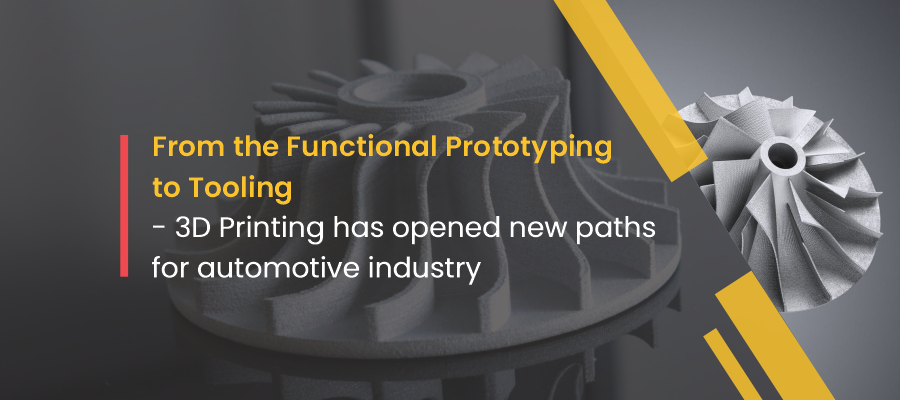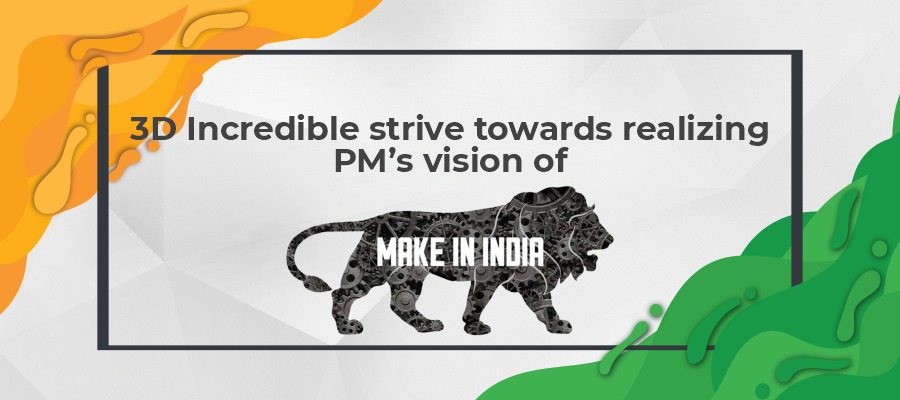The automotive industry is the most expeditious and complex sectors which poses several challenges and promising opportunities today. A list of obstacles faced by automotive industry include, the demand for vehicle electrification to diverse consumer preferences, to tighter environmental regulations, all have contributed to tightened vehicle production schedules and shortened vehicle life cycles. These pressures directly affect every OEM and supplier throughout the manufacturing chain. These issues require creative approaches to speed up the design process, increase quality and cut costs.
3D printing technology was introduced a few decades ago in the automotive sector to solve these issues and create automotive prototypes for checking the form and design of final product. With the onset of more robust technologies for automotive 3D printing, this method can now be used for manufacturing end-use parts and not only the prototypes. Adapting and optimizing to 3D printing is a cost effective solution for improving measurement, functional testing, vehicle customization, optimized design and rapid tooling.
Here is how the 3D printing technology opened paths for transformation in automotive industry:
1. Flexible and Optimized Design
Assistance of 3D printing in the early-stage vehicle design gives the benefit to start small and scale up rapidly, before assessment or the part reaches the assembly line. Prototyping is a key element of the manufacturing process in automotive sector which requires high detailing, smooth and accurate 3D printed scale models to demonstrate designs and concepts of new vehicles. The CAD models were not effective to define possible design problems hence, 3D printing now is one of the most popular ways to validate a prototype – from a small quickly printed detail to a high detail full-scale part suitable for performance validation and testing.
2. Rapid Tooling With Additive Manufacturing
Designing tooling with additive manufacturing from the very beginning removes multiple steps and untold costs compared with traditional tooling methods. Rapid tooling has become the major focus for many automotive customers, a trend that isexpected to grow in coming years. 3D printing can be used to make moulds and thermoforming tools, rapid manufacturing of grips, jigs, and fixtures. This allows automakers to produce samples and tools at low costs and eliminates future losses in production when investing in high-cost tooling.
3. Reduced Trial and Testing Time:
3D printing is tool less manufacturing technology that enables production of end part without tooling required. This saves the time required in manufacturing fixtures and setting up the tools. The transformation of digital cad file directly into physical end part accelerates the automotive product development process irrespective of material.
4. Fast Customization Via 3D Printing
Customization of vehicles, especially in the interiors is a costly endeavour for automotive industry.Mass production of a particular automotive feature in low-volume vehicles often proves too expensive for OEMs. However, 3D printing offers an economical solution to automakersproviding an array of trims and optionsfor consumers. Customizing interiors with 3D printing includes creating low-volume, specialized instrument panels that add features such as compartments for tools and instruments, as well as flexible dashboard features, such as GPS and satellite navigation systems.
5. Validation and Advanced Measurement
For the measurement and assembly of parts, 3D printing plays a critical role on the factory floor. A customised multifunctional tool can be manufactured using this method from a material of choice to measure several points on an assembly line of an automotive factory. It not only amalgamates different measurement steps into one, but also replaces tools made with steel or aluminium that have less functionality, therefore reducing costs.
6. Real World Functioning Testing
3D printing or additive manufacturing technology is used to manufacture real-sized parts of a vehicle for functional testing. It is also used to build complex parts (for the enginecompartment) that would withstand the functional tests for resistance to chemicals and heat.
Conclusion
With the onset of technology, 3D printing has evolved from an optional manufacturing option for producing relatively simple prototypes to an absolute necessity. Incredible AM Pvt. Ltd. is a leading additive manufacturing company providing innovative solution to automotive industry right from prototyping to tooling opening new opportunities for them. A leading company in manufacturing high quality and complex 3D printed parts. We have a world class facility for 3D printing and can supply those automotive tools, spare parts in a short span of time. Connect with us for more details regarding your industrial requirements.




